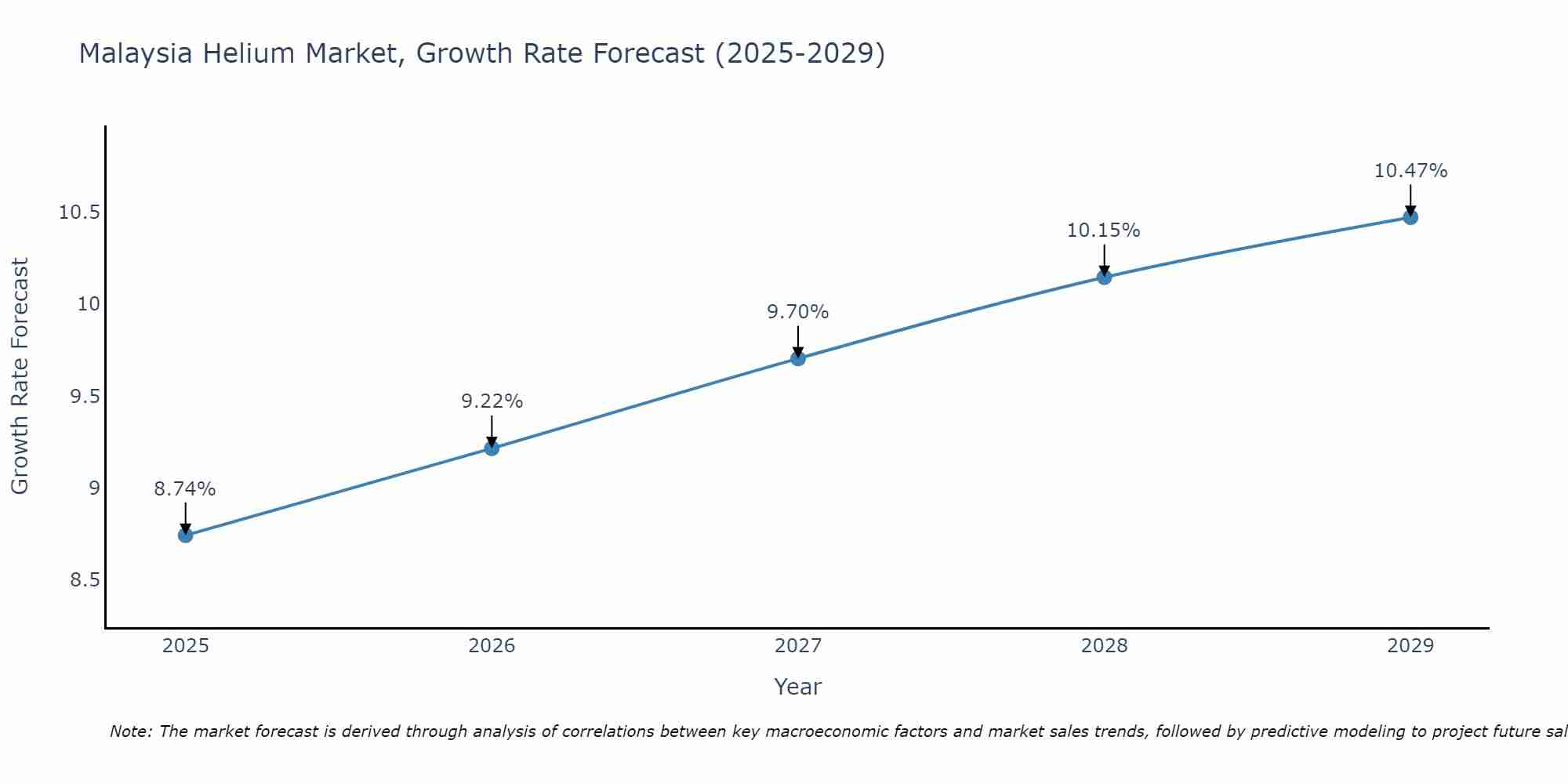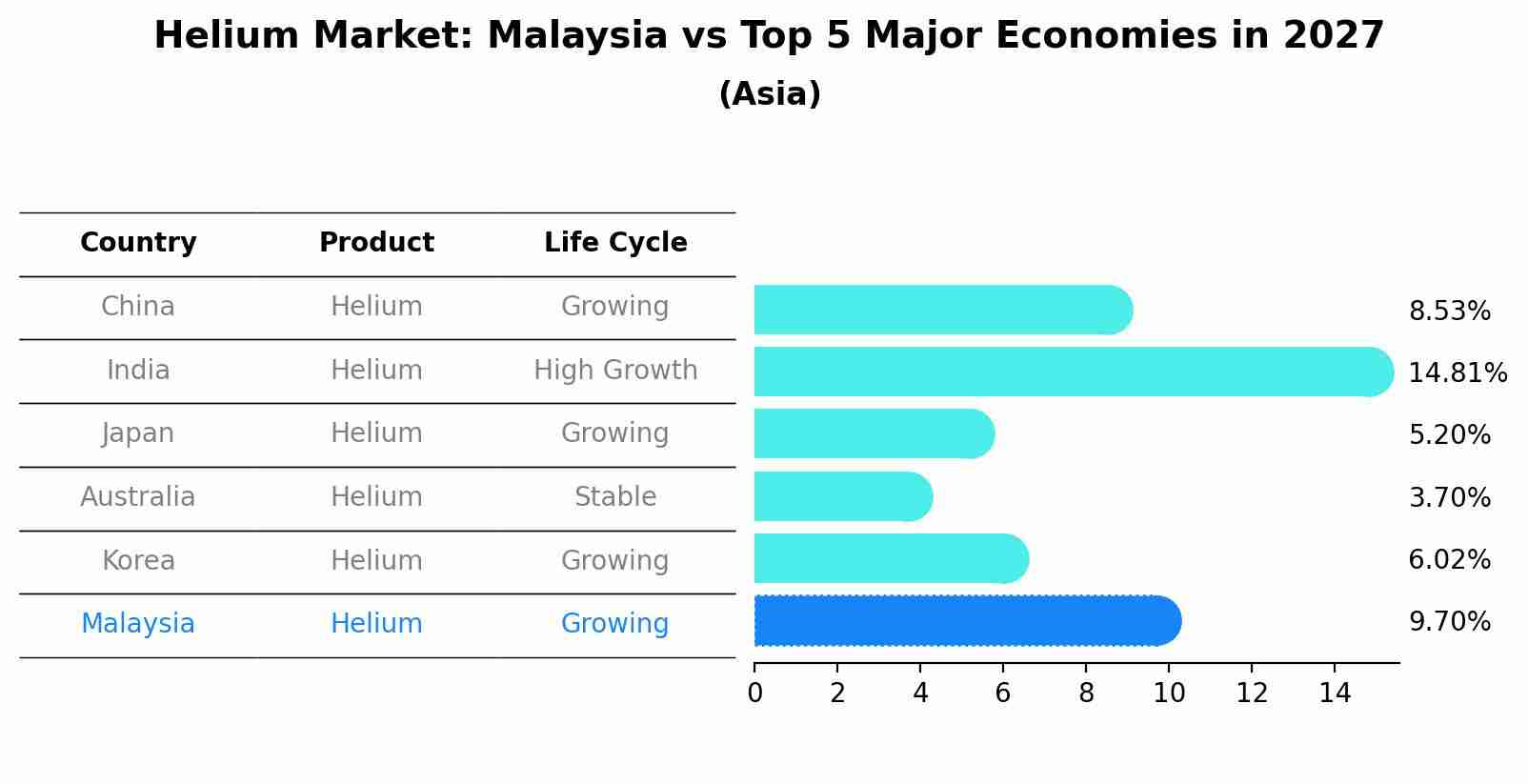Malaysia Helium Market (2025-2031) Outlook | Trends, Growth, Companies, Revenue, Industry, Share, Analysis, Forecast, Size & Value
| Product Code: ETC087105 | Publication Date: Jun 2021 | Updated Date: Apr 2025 | Product Type: Report | |
| Publisher: 6Wresearch | Author: Ravi Bhandari | No. of Pages: 70 | No. of Figures: 35 | No. of Tables: 5 |
Malaysia Helium Market Size Growth Rate
The Malaysia Helium Market is likely to experience consistent growth rate gains over the period 2025 to 2029. The growth rate starts at 8.74% in 2025 and reaches 10.47% by 2029.

Helium Market: Malaysia vs Top 5 Major Economies in 2027 (Asia)
Malaysia's Helium market is anticipated to experience a growing growth rate of 9.70% by 2027, reflecting trends observed in the largest economy China, followed by India, Japan, Australia and South Korea.

Malaysia Helium Market Synopsis
Helium is primarily used in welding operations due to its nonflammability properties. It helps maintain purity standards during critical welding processes such as arc welding or gas tungsten arc welding where oxygen contamination must be kept low. In addition, helium is also used as a coolant when temperatures get too high and poses an extreme risk of overheating otherwise sensitive components like electronic circuits or nuclear reactors. The Malaysiahelium market was valued at USD 0.3 million in 2025 and is expected to reach USD 0.5 million by 2025 with a CAGR growth rate of 6.4%. A key factor driving this growth is the increased usage of medical grade helium across healthcare centers coupled with ongoing technological advancements such as Proton Therapy which require liquid helium cooling systems
Market Drivers of the market
The Malaysia helium market outlook is driven by its various industrial applications. Helium is used in cryogenics, welding, and leak detection, among other industries. With Malaysia growing industrialization and the presence of helium reserves, the market is poised for growth.
Challenges of the market
The helium market faces challenges due to its limited availability and growing demand from various sectors, such as aerospace, healthcare, and electronics. The helium market requires efficient helium extraction and distribution processes to address supply constraints and maintain market stability.
Covid-19 Impact on the market
The helium market in Malaysia faced challenges as the healthcare sector witnessed shifts in medical gas demand during the pandemic. The medical industry`s focus on oxygen and medical gases impacted the helium market. Moreover, supply chain disruptions and logistical challenges affected product availability.
Key Players of the market
The helium market in Malaysia is supported by companies involved in the sourcing and distribution of helium gas for various applications, including cryogenics, aerospace, and electronics. Key players in Malaysia helium market may include HeliumGas Suppliers Sdn Bhd, AeroHeGas Technologies, and HeliumTech Solutions. These companies are likely to focus on reliable helium supply, meeting purity standards, and catering to the demand from research, medical, and industrial sectors.
Key Highlights of the Report:
- Malaysia Helium Market Outlook
- Market Size of Malaysia Helium Market, 2024
- Forecast of Malaysia Helium Market, 2031
- Historical Data and Forecast of Malaysia Helium Revenues & Volume for the Period 2021-2031
- Malaysia Helium Market Trend Evolution
- Malaysia Helium Market Drivers and Challenges
- Malaysia Helium Price Trends
- Malaysia Helium Porter's Five Forces
- Malaysia Helium Industry Life Cycle
- Historical Data and Forecast of Malaysia Helium Market Revenues & Volume By Type for the Period 2021-2031
- Historical Data and Forecast of Malaysia Helium Market Revenues & Volume By Liquid Helium for the Period 2021-2031
- Historical Data and Forecast of Malaysia Helium Market Revenues & Volume By Gaseous Helium for the Period 2021-2031
- Historical Data and Forecast of Malaysia Helium Market Revenues & Volume By End-users for the Period 2021-2031
- Historical Data and Forecast of Malaysia Helium Market Revenues & Volume By Aerospace and Aircraft for the Period 2021-2031
- Historical Data and Forecast of Malaysia Helium Market Revenues & Volume By Electronics and Semiconductors for the Period 2021-2031
- Historical Data and Forecast of Malaysia Helium Market Revenues & Volume By Nuclear Power for the Period 2021-2031
- Historical Data and Forecast of Malaysia Helium Market Revenues & Volume By Healthcare for the Period 2021-2031
- Historical Data and Forecast of Malaysia Helium Market Revenues & Volume By Welding and Metal Fabrication for the Period 2021-2031
- Historical Data and Forecast of Malaysia Helium Market Revenues & Volume By Other for the Period 2021-2031
- Historical Data and Forecast of Malaysia Helium Market Revenues & Volume By Application for the Period 2021-2031
- Historical Data and Forecast of Malaysia Helium Market Revenues & Volume By Breathing Mixes for the Period 2021-2031
- Historical Data and Forecast of Malaysia Helium Market Revenues & Volume By Cryogenics for the Period 2021-2031
- Historical Data and Forecast of Malaysia Helium Market Revenues & Volume By Leak Detection for the Period 2021-2031
- Historical Data and Forecast of Malaysia Helium Market Revenues & Volume By Pressurizing and Purging for the Period 2021-2031
- Historical Data and Forecast of Malaysia Helium Market Revenues & Volume By Welding for the Period 2021-2031
- Historical Data and Forecast of Malaysia Helium Market Revenues & Volume By Controlled Atmosphere for the Period 2021-2031
- Historical Data and Forecast of Malaysia Helium Market Revenues & Volume By Other for the Period 2021-2031
- Malaysia Helium Import Export Trade Statistics
- Market Opportunity Assessment By Type
- Market Opportunity Assessment By End-users
- Market Opportunity Assessment By Application
- Malaysia Helium Top Companies Market Share
- Malaysia Helium Competitive Benchmarking By Technical and Operational Parameters
- Malaysia Helium Company Profiles
- Malaysia Helium Key Strategic Recommendations
Frequently Asked Questions About the Market Study (FAQs):
1 Executive Summary |
2 Introduction |
2.1 Key Highlights of the Report |
2.2 Report Description |
2.3 Market Scope & Segmentation |
2.4 Research Methodology |
2.5 Assumptions |
3 Malaysia Helium Market Overview |
3.1 Malaysia Country Macro Economic Indicators |
3.2 Malaysia Helium Market Revenues & Volume, 2021 & 2031F |
3.3 Malaysia Helium Market - Industry Life Cycle |
3.4 Malaysia Helium Market - Porter's Five Forces |
3.5 Malaysia Helium Market Revenues & Volume Share, By Type, 2021 & 2031F |
3.6 Malaysia Helium Market Revenues & Volume Share, By End-users, 2021 & 2031F |
3.7 Malaysia Helium Market Revenues & Volume Share, By Application, 2021 & 2031F |
4 Malaysia Helium Market Dynamics |
4.1 Impact Analysis |
4.2 Market Drivers |
4.3 Market Restraints |
5 Malaysia Helium Market Trends |
6 Malaysia Helium Market, By Types |
6.1 Malaysia Helium Market, By Type |
6.1.1 Overview and Analysis |
6.1.2 Malaysia Helium Market Revenues & Volume, By Type, 2021-2031F |
6.1.3 Malaysia Helium Market Revenues & Volume, By Liquid Helium, 2021-2031F |
6.1.4 Malaysia Helium Market Revenues & Volume, By Gaseous Helium, 2021-2031F |
6.2 Malaysia Helium Market, By End-users |
6.2.1 Overview and Analysis |
6.2.2 Malaysia Helium Market Revenues & Volume, By Aerospace and Aircraft, 2021-2031F |
6.2.3 Malaysia Helium Market Revenues & Volume, By Electronics and Semiconductors, 2021-2031F |
6.2.4 Malaysia Helium Market Revenues & Volume, By Nuclear Power, 2021-2031F |
6.2.5 Malaysia Helium Market Revenues & Volume, By Healthcare, 2021-2031F |
6.2.6 Malaysia Helium Market Revenues & Volume, By Welding and Metal Fabrication, 2021-2031F |
6.2.7 Malaysia Helium Market Revenues & Volume, By Other, 2021-2031F |
6.3 Malaysia Helium Market, By Application |
6.3.1 Overview and Analysis |
6.3.2 Malaysia Helium Market Revenues & Volume, By Breathing Mixes, 2021-2031F |
6.3.3 Malaysia Helium Market Revenues & Volume, By Cryogenics, 2021-2031F |
6.3.4 Malaysia Helium Market Revenues & Volume, By Leak Detection, 2021-2031F |
6.3.5 Malaysia Helium Market Revenues & Volume, By Pressurizing and Purging, 2021-2031F |
6.3.6 Malaysia Helium Market Revenues & Volume, By Welding, 2021-2031F |
6.3.7 Malaysia Helium Market Revenues & Volume, By Controlled Atmosphere, 2021-2031F |
7 Malaysia Helium Market Import-Export Trade Statistics |
7.1 Malaysia Helium Market Export to Major Countries |
7.2 Malaysia Helium Market Imports from Major Countries |
8 Malaysia Helium Market Key Performance Indicators |
9 Malaysia Helium Market - Opportunity Assessment |
9.1 Malaysia Helium Market Opportunity Assessment, By Type, 2021 & 2031F |
9.2 Malaysia Helium Market Opportunity Assessment, By End-users, 2021 & 2031F |
9.3 Malaysia Helium Market Opportunity Assessment, By Application, 2021 & 2031F |
10 Malaysia Helium Market - Competitive Landscape |
10.1 Malaysia Helium Market Revenue Share, By Companies, 2024 |
10.2 Malaysia Helium Market Competitive Benchmarking, By Operating and Technical Parameters |
11 Company Profiles |
12 Recommendations |
13 Disclaimer |
- Single User License$ 1,995
- Department License$ 2,400
- Site License$ 3,120
- Global License$ 3,795
Search
Thought Leadership and Analyst Meet
Our Clients
Related Reports
- Canada Oil and Gas Market (2026-2032) | Share, Segmentation, Value, Industry, Trends, Forecast, Analysis, Size & Revenue, Growth, Competitive Landscape, Outlook, Companies
- Germany Breakfast Food Market (2026-2032) | Industry, Share, Growth, Size, Companies, Value, Analysis, Revenue, Trends, Forecast & Outlook
- Australia Briquette Market (2025-2031) | Growth, Size, Revenue, Forecast, Analysis, Trends, Value, Share, Industry & Companies
- Vietnam System Integrator Market (2025-2031) | Size, Companies, Analysis, Industry, Value, Forecast, Growth, Trends, Revenue & Share
- ASEAN and Thailand Brain Health Supplements Market (2025-2031) | Strategy, Consumer Insights, Analysis, Investment Trends, Opportunities, Growth, Size, Share, Industry, Revenue, Segments, Value, Segmentation, Supply, Forecast, Restraints, Outlook, Competition, Drivers, Trends, Demand, Pricing Analysis, Competitive, Strategic Insights, Companies, Challenges
- ASEAN Bearings Market (2025-2031) | Strategy, Consumer Insights, Analysis, Investment Trends, Opportunities, Growth, Size, Share, Industry, Revenue, Segments, Value, Segmentation, Supply, Forecast, Restraints, Outlook, Competition, Drivers, Trends, Demand, Pricing Analysis, Competitive, Strategic Insights, Companies, Challenges
- Europe Flooring Market (2025-2031) | Outlook, Share, Industry, Trends, Forecast, Companies, Revenue, Size, Analysis, Growth & Value
- Saudi Arabia Manlift Market (2025-2031) | Outlook, Size, Growth, Trends, Companies, Industry, Revenue, Value, Share, Forecast & Analysis
- Uganda Excavator, Crane, and Wheel Loaders Market (2025-2031) | Strategy, Consumer Insights, Analysis, Investment Trends, Opportunities, Growth, Size, Share, Industry, Revenue, Segments, Value, Segmentation, Supply, Forecast, Restraints, Outlook, Competition, Drivers, Trends, Demand, Pricing Analysis, Competitive, Strategic Insights, Companies, Challenges
- Rwanda Excavator, Crane, and Wheel Loaders Market (2025-2031) | Strategy, Consumer Insights, Analysis, Investment Trends, Opportunities, Growth, Size, Share, Industry, Revenue, Segments, Value, Segmentation, Supply, Forecast, Restraints, Outlook, Competition, Drivers, Trends, Demand, Pricing Analysis, Competitive, Strategic Insights, Companies, Challenges
Industry Events and Analyst Meet
Whitepaper
- Middle East & Africa Commercial Security Market Click here to view more.
- Middle East & Africa Fire Safety Systems & Equipment Market Click here to view more.
- GCC Drone Market Click here to view more.
- Middle East Lighting Fixture Market Click here to view more.
- GCC Physical & Perimeter Security Market Click here to view more.
6WResearch In News
- Doha a strategic location for EV manufacturing hub: IPA Qatar
- Demand for luxury TVs surging in the GCC, says Samsung
- Empowering Growth: The Thriving Journey of Bangladesh’s Cable Industry
- Demand for luxury TVs surging in the GCC, says Samsung
- Video call with a traditional healer? Once unthinkable, it’s now common in South Africa
- Intelligent Buildings To Smooth GCC’s Path To Net Zero


















